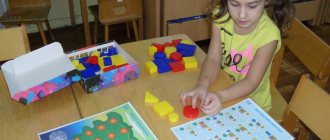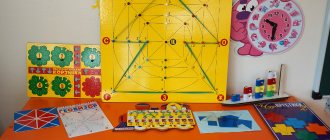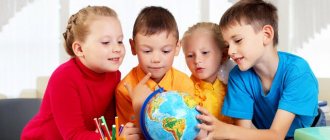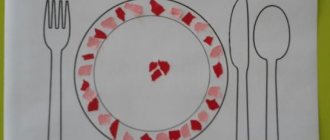Round table “Types of cultural practices and forms of their introduction into the lives of preschool children”
Elena Petrova
Round table “Types of cultural practices and forms of their introduction into the lives of preschool children”
1. What do you think it means to be a good teacher?
• What role does education play in the teaching profession?
• What set of personal and professional qualities should a teacher have? (competent speech, resistance to stress, ability to resolve conflicts, ability to listen, find a common language with parents, cultivate correct values, have an understanding of children’s pedagogy and psychology)
• What special knowledge, abilities and skills does a teacher need in his work? (master the methods of preschool education , constantly work on oneself, have special skills, master innovative technologies, non-traditional methods, know a computer, be able to use the Internet. The teacher must take into account the age characteristics of children, find an individual approach to them, respect them. The teacher must be creative personality. The teacher must be interesting to children - be able to sing, dance, “live up”
dolls, read poetry, tell fairy tales, sew, draw, make toys from natural materials, from paper, from bottles and jars, from lids and boxes and much more).
2. What do you think a modern teacher should be like?
• What qualities to have (patience, goodwill, to be beautiful, neat, regardless of everyday troubles - always cheerful , cheerful, have a sense of humor, a creative worker, a master of his craft, an innovator, leading a healthy lifestyle , who uses the latest technologies in his work methodological developments)
• What character traits should a teacher combine (this is a person who combines the traits of a psychologist, an artist, a friend, and a mentor).
The teaching profession is one of the most important and significant in the life of modern society. Being a teacher is a calling. This means wanting and being able to relive childhood again and again with each child, seeing the world through his eyes, being surprised and learning with him, being invisible when the baby is busy with his own business, and indispensable when he needs help and support.
3. With the release of the Federal State Educational Standard for Preschool Education, special attention is paid to various types of children's activities and solving the problems of developing independence and creativity preschoolers In the text of the Federal State Educational Standard for Preschool Education ) a term appeared for the first time that had not previously been used in Soviet preschool pedagogy . Paragraph 2.11.2 states that the content section of the educational program of preschool educational organizations should present “features of educational activities of different types and cultural practices .” The introduction of a new term made us think about what cultural practices and what new they will bring to preschool education .
It should be noted that there is clearly no single interpretation of the term “ cultural practices ”
does not exist.
How can this concept be interpreted?
• These are ordinary, habitual methods and forms of self-determination , norms of behavior and activity.
types of independent activity, behavior and experience, based on the child’s current and future interests life
• This is the testing of new ways and forms of activity and behavior in order to satisfy diverse needs and interests.
• This is a spontaneous and sometimes mundane assimilation of various experiences of communication and group interaction with adults, peers and younger children.
• This is the acquisition of one’s own moral, emotional experience of compassion, care, empathy, help, etc.
Thus, cultural practices are various types of independent activity, behavior and experience, based on the child’s current and future interests life .
Cultural practices are situational , independent, adult- or child-initiated acquisition and repetition of various experiences of communication and interaction with people in various types of activities.
4. What are the main cultural practices mastered by preschoolers ?
types of cultural practices are identified in the literature :
• free practices of children's activities (play, productive, cognitive - research activities, etc.)
• practices of cultural identification and interaction of the child with the surrounding society (familiarization with the environment, productive activities, games)
.
• practices of game interaction (story-based - role-playing games, didactic games, outdoor games)
.
• Communicative practices (reading fiction, speech development, dramatization games.
• Cultural practices of a healthy lifestyle (physical development, education of cultural and hygienic skills ).
• Cultural practices for shaping behavior and attitudes (role-playing games, domestic work)
.
• Cultural practices of understanding the world and self-knowledge (cognitive, research, productive activities, moral and patriotic education, self-knowledge)
5. Through what types of children’s activities, according to the Federal State Educational Standard for Education, are cultural practices formed ? (FSES BEFORE clause 2.7.)
• gaming, including role-playing games, games with rules and other types of games
• communicative (communication and interaction with adults and peers)
• educational and research (studying objects of the surrounding world and experimenting with them)
• perception of fiction and folklore
• self-service and basic household work (indoors and outdoors)
• construction from various materials, including construction sets, modules, paper, natural and other materials
• fine art (drawing, modeling, applique,
• musical (perception and understanding of the meaning of musical works, singing, musical-rhythmic movements, playing children's musical instruments)
• motor (mastery of basic movements)
forms of child activity .
6. Leading cultural practice ?
The leading cultural practice is gaming practice , which makes it possible to create an event-organized space for the educational activities of children and adults.
7. Why are cultural practices ?
• Cultural practices form the general culture of a preschooler’s personality , develop their social, moral, aesthetic, intellectual, and physical qualities.
• Also, the cultural practices of childhood are a powerful tool for developing the child’s initiative, independence and responsibility, and creating the prerequisites for educational activities.
• As a result of the implementation of , the child’s universal skills are formed of life and activity on the basis of cultural norms .
8. Give examples of cultural practices that are formed in the process of your activities?
• Joint play between the teacher and children (role-playing, directing, dramatization, construction and construction games)
• Situations of communication and accumulation of positive socio-emotional experience.
• Creative workshops.
• Musical, theatrical and literary lounges. Purpose: to create conditions for the creative activity of children and free communication between the teacher and children on literary or musical material.
• Sensory and intellectual training is a system of tasks, mainly of a gaming nature.
• Experimentation.
• Children's leisure, for example: entertainment “Merry Matryoshka”
, entertainment
"Mother's Day"
, etc.
• Collective and individual labor activity
9. Name the conditions for organizing and conducting cultural practices .
• Conscious motivation of teachers.
• The teacher’s understanding of the features of organizing independent children’s activities (its structure, ways to support children’s interest, etc.)
• The teacher's readiness to organize the content of the activity.
• Teacher competence in the field of cultural practice .
• The teacher’s ability to organize a subject-spatial environment to develop children’s desire and interest to act independently.
• The ability to select the optimal equipment for independent action in the chosen direction.
• The teacher’s ability to create an intriguing beginning, a problematic situation for “launching”
cultural practice .
• The teacher’s ability to identify the child’s abilities and interests
• The teacher’s ability to maintain and develop interest in children’s cultural practices
10. In what directions is the process of Designing cultural practices in the educational process going?
• Who is their initiator?
• Cultural practices based on the initiatives of the children themselves
This is an independent children's activity that occurs both individually and in the process of cooperation with peers.
Children's activity is aimed at independent knowledge of the environment, searching for answers to questions that arise, individual and joint activities with peers.
• Cultural practices initiated, organized and directed by adults
Directed by the teacher to develop children’s independent activity, they are based on the support of children’s initiatives and interests.
The choice of cultural practices is aimed at enriching cultural experience , independence of behavior and activity, positive socialization and individualization of preschool children .
11. When does a child's practice become cultural ?
(when it creates opportunities for his daily activity, personal initiative, comprehension of everyday experience and the creation of his own creative products of activity on the basis of mastered cultural norms (where culture is the essential quality of any form of activity )."
12. Now we can answer the question “Why are cultural practices ?”
Who will answer?
• Cultural practices form the general culture of a preschooler’s personality , develop their social, moral, aesthetic, intellectual, and physical qualities.
• are a powerful tool for developing the child’s initiative, independence and responsibility, as well as creating the prerequisites for educational activities.
• with the help of cultural practices we implement targets at the stage of completion of the first stage of general education.
• cultural practices directly solve the problems of socialization.
Thus, we can conclude that it is advisable to use cultural practices in amplifying child development. For an adult, there is another opportunity to come into contact with the wonderful world of childhood and become a close friend for the child.
Childhood is not just a unique subculture . These are “the sprouts of a new cultural way of life , which can sprout only in spaces of autonomous cultural practices , where children in their own way, not at all as adults would like, enter human culture and modern civilization, becoming its authors” (N. B Krylova – Candidate of Philosophical Sciences)
.
Game-based cultural practices for educating humane feelings in children of senior preschool age
Bibliographic description:
Kondrashova, N.V. Playful cultural practices in the education of humane feelings in children of senior preschool age / N.V. Kondrashova, V.A. Myalkina. — Text: direct // Questions of preschool pedagogy. - 2022. - No. 3 (9). — P. 27-30. — URL: https://moluch.ru/th/1/archive/63/2564/ (access date: 01/19/2022).
The article presents the scientific and methodological foundations and examples of the use of gaming cultural practices in the process of educating humane feelings in children of senior preschool age.
Raising humane feelings in preschoolers is a very complex process aimed at understanding the importance of showing humane feelings towards each other, developing the skills to sympathize, empathize, rejoice, do good sincerely and be guided by the norms of humane behavior when assessing various situations and actions of people, as well as the manifestation of humane feelings of older preschoolers in everyday life in relation to each other.
Cultural practices are an effective means of instilling humane feelings. The cultural practices of preschoolers are considered by modern scientists and practitioners in the field of preschool education in many ways:
1) searching and testing new ways of behavior and acquiring moral experience in communicating with others;
2) ways of mastering positive life experiences of empathy, goodwill and love, friendship, help, care, altruism;
3) various types of independent activity, behavior and experience, based on the child’s current and future interests, including his usual methods of self-determination and self-realization, ensuring the implementation of cultural skills;
4) a universal and effective means of education, in which the child is a full-fledged subject of activity, interaction and communication [2–5; 9–11].
The play activity of preschoolers as a cultural practice, representing an integrative phenomenon, ensures the satisfaction of the current needs of the child and society by focusing on the potential social capabilities of children. Game cultural practice is consistent with the Federal State Educational Standard of preschool education; it is aimed at the formation of a general culture, the development of personal qualities, and ensuring the social success of preschool children” [2, p. 115; 4; 10–11].
Game cultural practice is designed based on the following principles: saturation with sociocultural content; development of game dynamics; maintaining a gaming atmosphere; integration of cognitive (mastering knowledge of the norms and rules of humane behavior), emotional-value (focus on humanism) and behavioral aspects (enriching the experience of humane behavior) of humane attitude [2; 4; 10–11].
Summarizing modern achievements of pedagogical theory and practice, it should be noted that game-based cultural practices for the education of humane feelings can be varied in the forms of organization: guessing games, travel games, experimentation games, games to enrich moral experience [1–11]. It is effective to use guessing games when children verbally project possible options for the development of events, taking into account several options for the development of events (in the case of the manifestation or non-display of humane feelings, the commission of moral actions). For example, in the game “Complicated Situations,” preschoolers are asked to evaluate the behavior of the participants in a certain story (a fragment from a fairy tale or work of art is read) in which a friendly and humane attitude towards others, a loyal attitude to a different opinion or idea, etc. is required. Next, children are asked to come up with a different one. the course of events taking into account the change in behavior of one of the heroes, who unexpectedly becomes humane and kind [2; 4; 6; 10–11].
During experimental games, preschoolers use magical objects or find themselves in an unusual situation and have the opportunity to comprehend or perform humane actions. For example, in the game “Magic Glasses,” the teacher announces: “I want to show you magic glasses. The one who puts them on sees only the good in others and even the good that a person sometimes hides from everyone.” First, the teacher evaluates and praises the children wearing these glasses, and then asks each child to try on such glasses in turn so that they can see and name the merits of their comrades. If someone finds it difficult, you can help and suggest. Repetition of the same virtues is not scary here, although it is advisable to expand the circle of good qualities. In the game “Exchange Roles ”, participants exchange roles or game actions that they received when completing tasks. This allows you to: better understand another and be in his place, as well as look at the situation more broadly from two opposite positions, etc. [2–6].
During the game-travel in an imaginary situation, space and time are overcome, participants move to a certain place to view and evaluate specially prepared situations or perform moral actions. You can conduct a “Journey to the Land of Humane Actions” with 6 stops, during which preschoolers watch staged passages that are meaningfully aimed at the priority of universal human values and humane feelings and have the opportunity to evaluate the actions of the main characters through the prism of morality. Since the game can be played several times, children can take turns being actors and travelers, have the opportunity to clearly see the significance of showing a humane attitude towards another person and how actors can practice performing humane acts. The first stop is a dramatization game based on the story by V. Oseeva “Just an Old Lady”, stop 2. - a dramatization of the poem by E. A. Blaginina “Let’s Sit in Silence”, stop 3. - a dramatization of the story by K. D. Ushinsky “Together is crowded, but apart is boring ", stop 4. - game-dramatization based on the story by V. Oseeva "Three Comrades", stop 5. - game-dramatization based on the story by V. Oseeva "Blue Leaves", stop 6. game-dramatization based on the story by N. Nosov "Policeman" [6–8].
You can create “ theater of proverbs”, where characters from fairy tales and literary works perform with proverbs consonant with their plots. This will allow the teacher to relieve the monotony of ethical conversations and classes if it is necessary to return to the same object being studied. Children will willingly play the role of puppeteer. One of the final forms of working with proverbs can be a journey through the country of proverbs. This will be a week of children's creativity, each day of which has its own idea and motto. For example: “Kindness”, “Sympathy”, “Joyfulness”, “Responsiveness”, “Sensitivity”, etc.
Games to enrich moral experience involve the direct practice by participants of moral actions, humane feelings and relationships. For example, in the game “Compliments”, children stand in a circle and, looking into the eyes of their neighbor, say a few kind words to him, praise him for something or wish him something good. The game exercise is carried out in a circle. You can organize “Morning with , ” which the teacher proposes to make the motto of a certain day, can be the beginning of interesting work and life for the whole day (for example, “Life is given for good deeds”). During the day there are many reasons to remember the proverb. First, the teacher does this, then encourages the children to repeat and independently refer to the proverb [1–7].
You can organize it in the “ Proverbs Corner” group. This can be a small theatrical screen in the form of a hut pediment with an opening window, in which, depending on the child’s plan, a variety of characters can appear. Among various self-initiative theatrical games, you can initiate games with the use of proverbs through the mouths of a wide variety of characters.
In the game “Princess Nesmeyana,” an adult tells a fairy tale about Princess Nesmeyana and offers to play the same game. One of the children will be a princess who is sad and crying all the time, and the rest will take turns approaching her and trying to make her laugh and console her. The princess tries her best not to laugh. The one who manages to make her smile or laugh will win. At the same time, it is better to choose a rejected, uncommunicative child as Princess Nesmeyana, and the rest should try with all their might to cheer her up [3].
To encourage children who have committed humane acts, in kindergartens I use: “Reward Chest” (a box with various small surprises and small toys that bring children momentary joy and a little happiness); “Chest of sweets” with chewing candies, lollipops, etc.; “Card to Mom” (the teacher gives a thank you card in the evening and tells the child in front of other children about how well the child did); award badges (“Kind Heart”, “Knight and Day”, “Most Soulful”, etc.), which are awarded to children who have good potential, but who for some reason cannot fully realize it), etc.
So, the educational potential of gaming cultural practices can be considered in several aspects: the staging of works that are meaningfully aimed at the priority of universal human values and humanism helps to enrich the social and moral experience of preschool children; active participation in activities allows children not only to play the roles offered to them, but also to actively analyze the actions of the heroes from a moral point of view, compare them with their own behavior and thereby clarify their ideas about humanism; Performing actions approved by an adult and positively assessed by friends serves as an important incentive for preschoolers to further control their behavior and to perform similar actions in real life situations, etc.
Literature:
- Avramenko O. V. Pedagogical conditions for the formation of humanity in preschoolers in play activities: abstract of thesis. dis. Ph.D. ped. Sciences / Avramenko O.V. - Lipetsk, 1998. - 21 p.
- Buyanova E. M. Game-based cultural practices in preschool educational institutions // Cultural practices of modeling the educational environment of a preschool educational organization: materials of the All-Russian scientific-practical conference with international participation. — Irkutsk: Asprint, 2016. — pp. 114–116.
- Preschooler. — URL: https://doshkolnik.ru/nravstvennost/14427.html)
- Zaitseva O. I., Dreyling I. V. Game cultural practices as a priority of the Federal State Educational Standard of preschool education // Cultural practices of modeling the educational environment of a preschool educational organization: materials of the All-Russian scientific and practical conference. — Irkutsk: Asprint, 2016. — pp. 120–122.
- Kondrashova N.V. Spiritual and moral education of preschool children through play activities in a multicultural region // Polythematic network electronic scientific journal of the Kuban State Agrarian University. - 2012. - No. 7. - URL: https://ej. kubagro.ru/2012/07/pdf/45.pdf
- Kondrashova N.V., Myalkina V.A. Nurturing humane feelings as one of the important tasks of spiritual and moral education of preschoolers in a modern kindergarten // Concept. - 2016. - T. 15. - URL: https://e-koncept.ru/2016/96257.htm.
- Kondrashova N.V., Shorcheva M.O. Moral and spiritual education of preschool children through folk tales // Concept. - 2014. - No. 4. - URL: http: //ekoncept.ru/2014/14080.htm
- Kondrashova N.V. Formation of value orientations in theatrical games // Educator. - 2011. - No. 7. - P. 69–74.
- Krylova N. B. Free education in family and school: cultural practices of children. M.: September, 2007. - 192 p.
- Mokshina O. V. Playful activity of a preschooler as a cultural practice // Cultural practices of modeling the educational environment of a preschool educational organization: materials of the All-Russian scientific-practical conference. - Irkutsk: Asprint, 2016. - pp. 139–140.
- Pushkina N.V. Game activity of preschoolers as a cultural practice // Cultural practices of modeling the educational environment of a preschool educational organization. — Irkutsk: Asprint, 2016. — pp. 153–155.
Key terms
(automatically generated)
: game, humane attitude, humane behavior, child, feeling, preschooler, preschool education, playful cultural practice, moral experience, effective means of education.
“Cultural practice as a form of work with preschoolers in the conditions of the Federal State Educational Standard for Education” - presentation
“Cultural practice as a form of work with preschoolers in the conditions of the Federal State Educational Standard for Education”
What is “cultural practice”? Cultural practice... SITUATION OF COMMUNICATION, COOPERATION ACCEPTANCE OR NON-ACCEPTANCE OF SOMETHING, FORMATION OF A SYSTEM OF VALUES ACQUISITION AND REPEATING DIFFERENT COMMUNICATION EXPERIENCES, CULTURAL NORMS DEVELOPMENT OF POSITIVE LIFE EXPERIENCE
IMPACT INTERACTION IS IMPORTANT! The result of the implementation of cultural practices is the child’s readiness and ability to act in all circumstances of life and activity on the basis of cultural norms, the acquisition of cultural standards. The main goal of organizing cultural practices:
1. Legal practices are practices of a child’s readiness to defend, protect their rights and the rights of other people, using both knowledge of the rights and freedoms themselves and the ability to implement them. RESULT! Instilling in preschoolers respect and tolerance for each other, developing a sense of self-esteem, awareness of their rights and freedoms; a sense of responsibility for another person, the ability to control one’s behavior, involvement in activities that comply with social norms and rules of behavior. IMPORTANT! Development of rules! Types of cultural practices (Maslovskaya S.V., candidate of pedagogical sciences, associate professor)
2. Practices of cultural identification are practices of a child’s knowledge of the world of culture, as well as the child’s awareness, spiritualization and realization of himself in the world of culture. RESULT! Formation of a child’s idea of: himself, family traditions; about the world, society, its cultural values; about the state and belonging to it; the child’s implementation of his own artistic concept and its embodiment in a drawing, story, etc., the child’s integration into national, Russian and world culture, taking into account regional characteristics. IMPORTANT! Inclusion of research and productive-creative activities! Types of cultural practices (Maslovskaya S.V., candidate of pedagogical sciences, associate professor)
3. Practices of the integrity of the body-mental-spiritual organization of a child’s personality is the child’s ability and ability to purposefully (safely) cognize, create, and transform natural and social reality. RESULT! Mastery of basic cultural and hygienic skills, adherence to basic rules of a healthy lifestyle, the ability to plan cognitive and research activities, manifestation of perseverance and volitional effort in searching for answers to questions, mastering the rules of safe behavior. Types of cultural practices (Maslovskaya S.V., candidate of pedagogical sciences, associate professor)
4. Practices of freedom - practices of a child choosing independent activities in the conditions of a subject-based developmental educational environment created by a teacher, ensuring that each child chooses activities according to his interests and allowing him to interact with peers or act individually. RESULT! Taking active and interested participation in the educational process; the ability to seek help from an adult; the ability to manage one's behavior; the ability to act independently (in everyday life, in various types of children's activities), the manifestation of initiative and creativity. Types of cultural practices (Maslovskaya S.V., candidate of pedagogical sciences, associate professor)
5. Practices of expanding the child’s capabilities - practices of developing the child’s ability to identify necessary and sufficient conditions for the realization of reality. RESULT! Development of the ability to solve age-appropriate intellectual tasks (problems); application of independently acquired knowledge and methods of activity to solve new tasks (problems) posed by both adults and themselves; ability to transform ways of solving problems (problems). Types of cultural practices (Maslovskaya S.V., candidate of pedagogical sciences, associate professor)
Types of children's activities for children from 3 to 8 years old (FSES DO clause 2.7) Play, including role-playing games, games with rules and other types of games; Communicative; Cognitive and research; Perception of fiction and folklore Self-service and basic household work Construction Fine (drawing, modeling, appliqué); Musical Motor
1. JOINT GAME OF THE TEACHER AND CHILDREN (role-playing, directing, dramatization games, construction games, etc.) Purpose: enriching the content of creative games, children mastering the gaming skills necessary to organize independent play. Forms of cultural practices in accordance with the main activities
2. SITUATIONS OF COMMUNICATION AND ACCUMULATION OF POSITIVE SOCIAL AND EMOTIONAL EXPERIENCE Goal: developing the ability to resolve problem situations close to preschool children. Forms of cultural practices in accordance with the main activities
3. CREATIVE WORKSHOPS Purpose: creating conditions for children to use and apply knowledge and skills in practice, developing creative abilities, etc. REQUIRED CONDITION! RESULT Forms of cultural practices in accordance with the main activities
4. MUSICAL, THEATRICAL AND LITERARY LOUNGS Purpose: to create conditions for the creative activity of children and free communication between the teacher and children on literary or musical material. Forms of cultural practices in accordance with the main activities
5. SENSORY AND INTELLECTUAL TRAINING IS a system of tasks, mainly of a playful nature, ensuring the formation of a system of sensory standards (color, shape, spatial relationships, etc.), methods of intellectual activity (the ability to compare, classify, systematize according to any criteria, etc. ). Goal: development of logical thinking, memory, attention, perception. Forms of cultural practices in accordance with the main activities
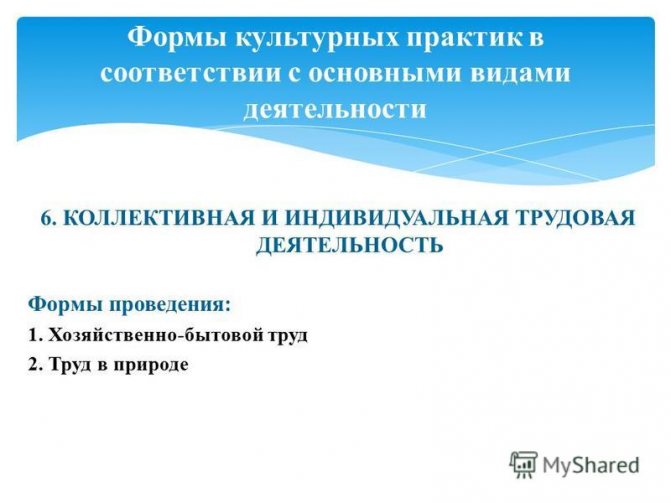
6. COLLECTIVE AND INDIVIDUAL LABOR ACTIVITY Forms of implementation: 1. Household work 2. Labor in nature Forms of cultural practices in accordance with the main types of activity
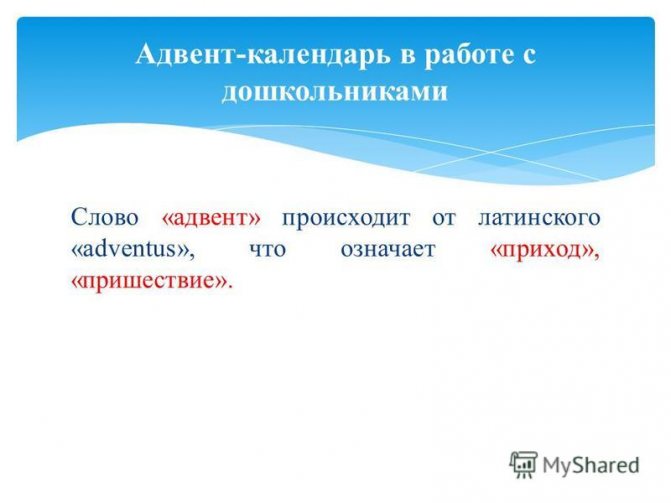
The word "Advent" comes from the Latin "adventus", which means "coming", "coming". Advent calendar in working with preschoolers
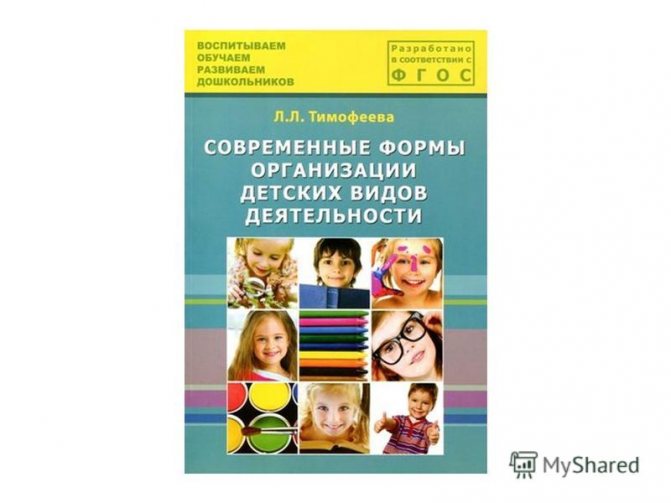

THANK YOU FOR YOUR ATTENTION!!!
